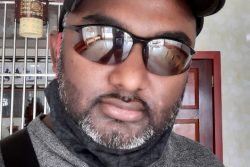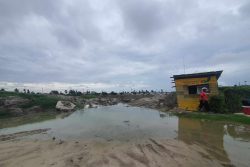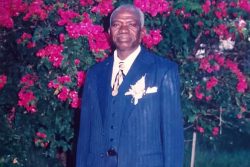Last Sunday fisherman Mr Kishan Budburgh and Police Corporal Dwayne McPherson were fatally shot during a police operation at Mahaicony. According to Mr Budburgh’s mother, her son had been in a fight with another man in a shop, and after the man hit him on the back of the head, he stabbed the assailant. The two were then parted by one of Mr Budburgh’s brothers.
The police entered into the story after Mr Budburgh had returned home, she said, and they came to arrest him. She alleged that the police started to hit him with a gun, and he resisted, fighting back with Corporal McPherson. According to her account it was at this point that one of the other policemen opened fire hitting the Corporal, and then her son tried to make good his escape following which he too was shot. The autopsy results showed that the fisherman had been hit three times and the policeman twice. Another very serious allegation she made was that the police immediately conveyed Mr McPherson to the hospital, but Mr Budburgh was left for four hours in total, during which time he died.
The GPF informed the public that two police ranks were currently being held under close arrest in connection with the shootings, and that the case file was with the Head of the Office of Professional Responsibility. They went on to say that “regular” updates would be provided, although these, it must be said, are notable by their absence. It should be emphasised too that it is not just the matter of the shootings which needs to be investigated, but also the fact that Mr Budburgh was not taken to hospital immediately at the same time as Mr McPherson. That is inexcusable.
Unfortunately the shooting of unarmed civilians is hardly a rare occurrence in this country, and there have been a number of instances, some of them high-profile, which preceded this one. Last year the case of Quindon Bacchus came to public attention when he was shot dead in June after what was initially claimed to be a shootout with police officers. On that occasion Lance Corporal Kristoff DeNobrega was charged with his murder a month later, while two other officers faced charges of obstruction of justice because they had allegedly tried to cover up the way in which Mr Bacchus had been killed.
A case which attracted a great deal of concern was that of Orin Boston in 2021, whose wife had told reporters that the police had kicked down their back door and entered the bedroom where Mr Boston was shot. The police version was that they were engaged in an anti-crime operation and that there was a “confrontation” between them and Mr Boston.
While that case attracted considerable attention, there were others, and after four civilians were shot by the police in the space of two months towards the end of 2021, the political party ANUG had written the Chief Magistrate and Magistrate Sam calling for inquests into the deaths of those who died in keeping with the provisions of the Coroner’s Act. The purpose of an inquest, the party said, was to determine whether any individual(s) should be charged criminally for the deaths. Certainly inquests in general seem to have faded away for the most part, and their robust revival might be one small step towards holding the police accountable in matters of this kind. Whether or not persuaded by the party’s arguments, in November of the same year the DPP did recommend an inquest into the death of Peter Headley, who had been killed six months earlier while being transported to the Providence Police Station.
While he had not directed his remarks only to unlawful killings by the police, a previous Police Commissioner, Mr Nigel Hoppie, had made reference to the low academic requirements for entry into the Police Force, which contributed to the poor conduct of some officers, including where corruption and the excessive use of force were concerned. At the moment all that is required is a sound primary-school education, he said, and he expressed the view that a higher level of education was needed. At the time Minister Robeson Benn could have been interpreted as supporting this approach when he commented: “We need to improve the intake of the Police Force beyond the question of diversity.”
Mr Hoppie’s argument no doubt would find support in the wider society where it is recognised that the police need not just to be familiar with the laws, but to display respect in their dealings with the public and be possessed of judgement in situations of confrontation. In particular they require a capacity for fairness and even-handedness, something which many of them, although not necessarily all of them, will not develop on the basis of a primary school education. The problem is that the Force is unlikely to attract more qualified applicants given its current pay rates, its reputation for corruption and its lack of professionalism. Developing a professional GPF which has high morale would also necessitate its depoliticization, which no government so far has shown any appetite for.
In the meantime, the problem of ‘excessive force’ as Mr Hoppie described it, still has to be dealt with. While no doubt police recruits are trained in the matter of when to use firearms, those lessons are clearly often forgotten in the heat of the moment. And so many police carry weapons nowadays, which was not always the case in the past. One supposes that the argument is that they have to be armed considering the amount of guns circulating in the society. However, one does have to wonder whether they are properly trained in unarmed arrest, where the suspect, even if he resists, does not have a firearm in his possession. The case of Mr Budburgh would clearly seem to suggest that he could have been subdued without any weapon being fired, more particularly since more than one officer was present. What seems to happen is that in some cases the first resort of officers on the scene is their gun, even when other options are available.
The best protection for the police in some circumstances, as well as the public for a variety of reasons and not just unlawful killings by members of the Force, is what are colloquially known as body-cams. All 12 divisions have been issued with them, but in their current numbers they are probably only of very limited use. There are simply not enough of them for every rank on duty. This newspaper was told in 2021 that there were 180 of them, and Mr Benn said that plans were in the pipeline to source another 500 with the funds allocated in the Budget of that year. As such, according to the Region Six Commander at the time, attempts were made to ensure that at least one rank in a team had one.
Perhaps different Division Commanders had different emphases, depending on the nature of crime in their area. In a general sense Senior Superintendent of the GPF IT Department Jermaine Johnson told SN that the cameras were used by ranks of the Traffic Department, anti-crime patrols, riot units, in the courts and on general duty. In the case of the unlawful killings adverted to above, as far as can be established body-cams were not in use. It was explained by the Commander of Division 4B that it was the call of the officer-in-charge as to whether one rank would be kitted out with the equipment. In the case of Division 3 the Commander said that the body-cams were mostly used for the anti-crime patrol, while in Division 6 we were told that every police station had two, and they were used on raids and patrols and when ranks were interfacing with people.
In the case of Region 4B the Commander said officers were often advised to use them, and if those who should have been using them failed to do so, they would face consequences. Well if this sounds promising, there are certain technical and other issues apart from their numerical insufficiency militating against body-cams becoming an invaluable resource. One senior police officer told this newspaper that even after training some police personnel had difficulty using the equipment while on duty. “Even though we do training, some of the ranks don’t really understand how to access back the information and those things,” he was quoted as saying.
That is not the only problem: there is the matter of insufficient storage capacity and battery power, so the camera can only run for a limited time, which on average is 45 minutes. There has to be some judgement therefore about when it is turned on, which is not always easy to assess, particularly if the wearer has to go out on more than one duty, and it is turned on for the first, but is more required for the second, say, when it has run out. Some of the body-cams have greater capacity because they have 256 GB memory, while the others have only 32 GB. One can only hope that Minister Benn sees fit to have imported a large number of body-cams so that a significant number of officers wear them. In such circumstances if two or more ranks are equipped when on an assignment they don’t have to run them simultaneously. He should also look at their memory capacity. In addition too, the matter of training the users is in need of revisiting.
Finally, if this government is serious about protecting the public from wrongful acts on the part of the police, it is about time they finally acceded to the creation of an independent police complaints authority, which does not have to rely on the resources of the police themselves for the purposes of investigation. Acting Commissioner Clifton Hicken at his end-of-year comments had promised greater resources for the existing arrangements. It is not good enough; a complaints authority which will secure the trust of the public has to be independent.






